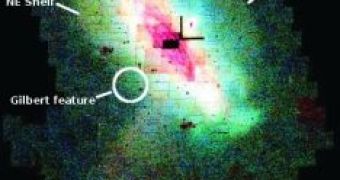An association of stars in the edges of Andromeda galaxy may be the remnants of a distinct galaxy that was included within Andromeda about 700 million years ago.
Astronomer Mark Fardal at the University of Massachusetts Amherst had already modeled a simulation of a dwarf galaxy merging with Andromeda.
"Large galaxies are believed to be built partly by the merging of smaller galaxies, an event that destroys the smaller galaxy," explains Karoline Gilbert, a graduate student at the University of California, Santa Cruz.
The large galaxies possess powerful gravitational forces that can tear apart small ones, resulting loose streams of stars named tidal debris.
At a distance of 2.5 million light-years, Andromeda is the nearest large spiral galaxy to Milky Way, our own galaxy, which is also a spiral type.
Spiral galaxies compass a flat disk of stars and gas, a central mass of densely concentrated stars, and sometimes a faint star halo of stars extended over large distances.
Some of Andromeda's areas on the external side present a lower star density, which points they are likely tidal debris from past galaxy mergers.
Computer simulations and matched observations linked a stream of stars to the south of the galaxy, "the giant southern stream," and a faint zone to one side of Andromeda's disk "the northeast shelf" to be in fact the result of the merger of a dwarf galaxy with Andromeda.
"The tidal debris feature we have discovered is almost an exact match with the feature predicted in the simulations. This implies that this new stellar stream and the giant southern stream, as well as the other stellar features reproduced in the Fardal simulations, are all from the same parent galaxy," said Gilbert.
"In the model, the two galaxies first collided about 700 million years ago," explains Fardal.
The smaller galaxy was roughly 2 billion Sun's worth of stars while Andromeda is fifty times bigger.
"Eventually, the tidal debris from the satellite galaxy will smear out and be indistinguishable from the rest of the halo," said Fardal.
"Gilbert's discovery of a new tidal debris feature, combined with velocity measurements of the other related tidal debris, will provide observations necessary to measure how much dark matter is in Andromeda and how it is distributed," explains Fardal.
The research group employed the sensitive DEIMOS spectrograph at the Keck Observatory in Hawaii to distinguish light of different colors from individual stars in the Andromeda's disk.
Photo credit: Mark Fadal.

 14 DAY TRIAL //
14 DAY TRIAL //